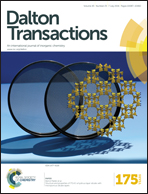Chromophore-labelled, luminescent platinum complexes: syntheses, structures, and spectroscopic properties†
Abstract
Ligands based upon 4-carboxamide-2-phenylquinoline derivatives have been synthesised with solubilising octyl hydrocarbon chains and tethered aromatic chromophores to give naphthyl (HL2), anthracenyl (HL3) and pyrenyl (HL4) ligand variants, together with a non-chromophoric analogue (HL1) for comparison. 1H NMR spectroscopic studies of the ligands showed that two non-interchangeable isomers exist for HL2 and HL4 while only one isomer exists for HL1 and HL3. Supporting DFT calculations on HL4 suggest that the two isomers may be closely isoenergetic with a relatively high barrier to exchange of ca. 100 kJ mol−1. These new ligands were cyclometalated with Pt(II) to give complexes [Pt(L1–4)(acac)] (acac = acetylacetonate). The spectroscopically characterised complexes were studied using multinuclear NMR spectroscopy including 195Pt{1H} NMR studies which revealed δPtca. −2785 ppm for [Pt(L1–4)(acac)]. X-ray crystallographic studies were undertaken on [Pt(L3)(acac)] and [Pt(L4)(acac)], each showing the weakly distorted square planar geometry at Pt(II); the structure of [Pt(L3)(acac)] showed evidence for intermolecular Pt–Pt interactions. The UV-vis. absorption studies show that the spectral profiles for [Pt(L2–4)(acac)] are a composite of the organic chromophore centred bands and a broad 1MLCT (5d → π*) band (ca. 440 nm) associated with the complex. Luminescence studies showed that complexes [Pt(L2–4)(acac)] are dual emissive with fluorescence characteristic of the tethered fluorophore and long-lived phosphorescence attributed to 3MLCT emission. In the case of the pyrenyl derivative, [Pt(L4)(acac)], the close energetic matching of the 3MLCT and 3LCpyr excited states led to an elongation of the 3MLCT emission lifetime (τ = 42 μs) under degassed solvent conditions, suggestive of energy transfer processes between the two states.



 Please wait while we load your content...
Please wait while we load your content...